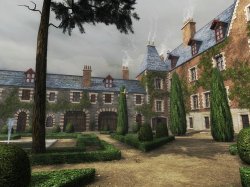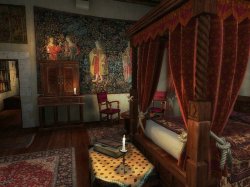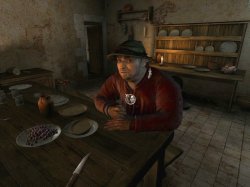|
The Secrets of Da Vinci: The Forbidden Manuscript
 Well it's lucky that The Secrets of Da Vinci: The Forbidden Manuscript has appeared right at this point in time with all the fuss and controversy over Dan Brown's popular novel, The Da Vinci Code, and the equally controversial film of the novel. Any game (and there is a Da Vinci Code game based on Dan Brown's tale) anything to do with Da Vinci is bound to attract attention. So let me say right from the start, this game in no way follows The Da Vinci Code book, or the movie, or the game.
The Secrets of Da Vinci: The Forbidden Manuscript is a totally different treatment of the Da Vinci theme and, as an adventure game, it's very well done. It isn't a modern day conspiratorial tale, it's a conspiratorial tale set in the year 1522, in the Cloux Manor where Da Vinci lived for 3 years prior to his death. You play Valdo, a disgraced pupil of Da Vinci's friend and heir, Francesco Melzi. A mysterious benefactor has asked you to befriend Marie Babou de la Bourdaisiere (Babou for short) who lives at the manor. The official reason for your visit is to find some of Da Vinci's machines and a missing sketch, but the real reason is to find an unpublished codex. Well it's lucky that The Secrets of Da Vinci: The Forbidden Manuscript has appeared right at this point in time with all the fuss and controversy over Dan Brown's popular novel, The Da Vinci Code, and the equally controversial film of the novel. Any game (and there is a Da Vinci Code game based on Dan Brown's tale) anything to do with Da Vinci is bound to attract attention. So let me say right from the start, this game in no way follows The Da Vinci Code book, or the movie, or the game.
The Secrets of Da Vinci: The Forbidden Manuscript is a totally different treatment of the Da Vinci theme and, as an adventure game, it's very well done. It isn't a modern day conspiratorial tale, it's a conspiratorial tale set in the year 1522, in the Cloux Manor where Da Vinci lived for 3 years prior to his death. You play Valdo, a disgraced pupil of Da Vinci's friend and heir, Francesco Melzi. A mysterious benefactor has asked you to befriend Marie Babou de la Bourdaisiere (Babou for short) who lives at the manor. The official reason for your visit is to find some of Da Vinci's machines and a missing sketch, but the real reason is to find an unpublished codex.
Thus The Secrets of Da Vinci is a historical adventure of exploration and intrigue with some quite fascinating locations as the graphics are modelled on the Cloux Manor which is now a museum. In the manor itself there's an assortment of plush living areas with familiar Da Vinci paintings adorning the walls. Elaborate furniture fills the rooms and the rugs and bed coverings are so detailed and richly textured. There's a massive kitchen as well, plus Da Vinci's study and workshop with various interactive contraptions such as printing equipment, some woodworking devices, painting easels and a still. Immediately outside are the gardens and, once you cross the bridge there's the forge and dovecote to visit as well.
Maybe the game world isn't huge but the graphics are certainly evocative of the period. Carefully crafted, with dingy dark corners contrasting with bright, lamp lit areas. Fires burn, and some of them crackle in their grates once you get them lit, and there's more to the manor than meets the eye if you solve some puzzles to open secret ways.
 Movement is step mode with full panning at each step so you can look around in all directions. Just move the mouse to shift your view. There are no transitions between steps but the gameworld is fascinating enough for this not to be a problem. What would have helped, though, would have been some gentle movement of the trees and foliage outside in the gardens to simulate a breeze, or maybe some falling leaves. The gardens are beautiful but their static nature tends to conjure up the feeling of a painting rather than a place. To move the story along there are one or two cinematic cut scenes but most are simple sketches with narration which serve the same purpose, and a there are also a few sepia flashbacks where Da Vinci makes an appearance.
The Secrets of Da Vinci is a first person perspective, mouse driven game, with the excellent trade mark multi level inventory from Kheops Studios as in games like Voyage and Return to Mysterious Island. Again just click the tabs to open the 5 inventory pockets. There are a lot of items to collect so it's once more good to have plenty of space to organise your collection. This time, however, there is no separate collection tray for items as you pick them up because they go straight into inventory. I missed this feature as it is not so convenient when you have to search for items before you can organise them. Just a little extra sorting, but not too bad. Movement is step mode with full panning at each step so you can look around in all directions. Just move the mouse to shift your view. There are no transitions between steps but the gameworld is fascinating enough for this not to be a problem. What would have helped, though, would have been some gentle movement of the trees and foliage outside in the gardens to simulate a breeze, or maybe some falling leaves. The gardens are beautiful but their static nature tends to conjure up the feeling of a painting rather than a place. To move the story along there are one or two cinematic cut scenes but most are simple sketches with narration which serve the same purpose, and a there are also a few sepia flashbacks where Da Vinci makes an appearance.
The Secrets of Da Vinci is a first person perspective, mouse driven game, with the excellent trade mark multi level inventory from Kheops Studios as in games like Voyage and Return to Mysterious Island. Again just click the tabs to open the 5 inventory pockets. There are a lot of items to collect so it's once more good to have plenty of space to organise your collection. This time, however, there is no separate collection tray for items as you pick them up because they go straight into inventory. I missed this feature as it is not so convenient when you have to search for items before you can organise them. Just a little extra sorting, but not too bad.
A journal keeps track of your objectives so it's handy to refer to it often. Each objective is crossed out when completed. Along with the journal there is also a portfolio where Valdo stores any documents he collects. Here you will find clues for various tasks and actually solve a few puzzles as well because some of the sketches can be manipulated to simulate completing particular tasks. This was an a novel (and probably economical) way to insert more puzzling although it did take a short while before I realised the portfolio was interactive. An alert, perhaps in the manual, would have helped.
There are a variety of other puzzles and challenges in The Secrets of Da Vinci. Items to find and use appropriately, cryptic clues to unravel, a password of sorts to find, plus using some of Da Vinci's apparatus including the still, the printing device, the forge etc. It's a do-it-yourself experience, so if you need an item, paper or perfume for instance, then it's up to you to make it. Admittedly the processes are simplified, but they keep you busy. Added to this there are also a few more abstract challenges such as some music making and one of the tile sliding variety.
Generally the puzzles fit in naturally with the story and are not at all difficult. The exceptions might be the above music and sliding tile puzzles which cause great angst for many players. If you don't like slider puzzles there is a serendipitous glitch that solves it for you. Not so for the music puzzle. Although there are triggers that move on the storyline and open more puzzles, they are never elusive, and there is also a fair amount of openness for most of the game so that you can wander around and take in the scenery, fiddle with the various contraptions, perhaps even solve a puzzle.
 Talking to the two main characters, Babu and the Guardian of the Manor, Saturnin, is also important as they have some tasks for you, as well as some good advice. In fact you won't get far unless you do. There is an option to display subtitles and in conversation mode Valdo's questions appear at the bottom of the screen, it's just a matter of selecting each one. The dialogue is fairly well written although there are some places where the flow could have been better. The voice acting, too, is of varying quality but neither of these things detract from the game. The background music fades in and out and there are appropriate sound effects including creaking stairs and floorboards to build up atmosphere in the manor. There are different endings and slight variations for getting hold of some of the necessary items, but, thankfully, these variations never veer off in totally different directions so you don't feel like you've missed huge chunks of play when you reach the end.
The Secrets of Da Vinci also has the familiar Kheops Studio point system which I always appreciate. Another added extra is the Conscience Gauge which reflects your behaviour. Do good things and the good side goes up, misbehave and the bad side builds. It is possible to manually balance the gauge, if not you may find that you have fewer options for solving some of the puzzles. After all an angelic person would never do anything to harm anyone, and someone who strays from the straight and narrow might find a door shut in their face. This was an interesting idea and added a bit of novelty. I did a little experimentation and maybe it could have been used to better effect allowing more ways to influence Valdo's conscience meter, but it was fun just the same.
So another entertaining game from Kheops Studios, although the story could have been developed further. Because of its relative simplicity The Secrets of Da Vinci: The Forbidden Manuscript is a game that could be enjoyed by older children (say 10 years and up) as well as adults. Play it as a family, maybe, or there is the option for 5 people to play and save their games separately. There's lots of tasks to take care of, lots of goodies to collect, plus, of course, the opportunity to get to know a little about the versatility of the Great Master, Leonardo Da Vinci. Talking to the two main characters, Babu and the Guardian of the Manor, Saturnin, is also important as they have some tasks for you, as well as some good advice. In fact you won't get far unless you do. There is an option to display subtitles and in conversation mode Valdo's questions appear at the bottom of the screen, it's just a matter of selecting each one. The dialogue is fairly well written although there are some places where the flow could have been better. The voice acting, too, is of varying quality but neither of these things detract from the game. The background music fades in and out and there are appropriate sound effects including creaking stairs and floorboards to build up atmosphere in the manor. There are different endings and slight variations for getting hold of some of the necessary items, but, thankfully, these variations never veer off in totally different directions so you don't feel like you've missed huge chunks of play when you reach the end.
The Secrets of Da Vinci also has the familiar Kheops Studio point system which I always appreciate. Another added extra is the Conscience Gauge which reflects your behaviour. Do good things and the good side goes up, misbehave and the bad side builds. It is possible to manually balance the gauge, if not you may find that you have fewer options for solving some of the puzzles. After all an angelic person would never do anything to harm anyone, and someone who strays from the straight and narrow might find a door shut in their face. This was an interesting idea and added a bit of novelty. I did a little experimentation and maybe it could have been used to better effect allowing more ways to influence Valdo's conscience meter, but it was fun just the same.
So another entertaining game from Kheops Studios, although the story could have been developed further. Because of its relative simplicity The Secrets of Da Vinci: The Forbidden Manuscript is a game that could be enjoyed by older children (say 10 years and up) as well as adults. Play it as a family, maybe, or there is the option for 5 people to play and save their games separately. There's lots of tasks to take care of, lots of goodies to collect, plus, of course, the opportunity to get to know a little about the versatility of the Great Master, Leonardo Da Vinci.
Copyright © Rosemary Young 2006.
All rights reserved.
System Requirements:
Windows 98SE, 2000, ME or XP, Pentium III 800 Mhz (Pentium 4 1Ghz recommended), 64 MB RAM (256 MB recommended), 64 MB vRAM compatible DirectX 9 video card, compatible DirectX 9 Sound card, 16x CD Rom drive (24x recommended) keyboard and mouse, 1.2 GB free disk space.
|

